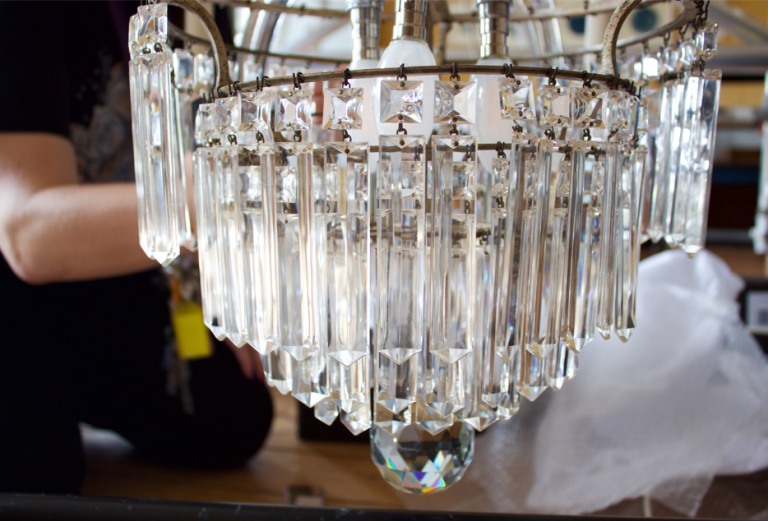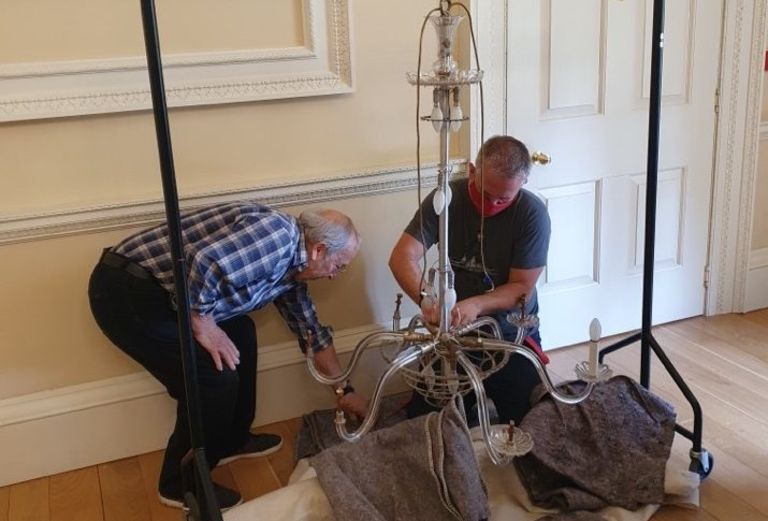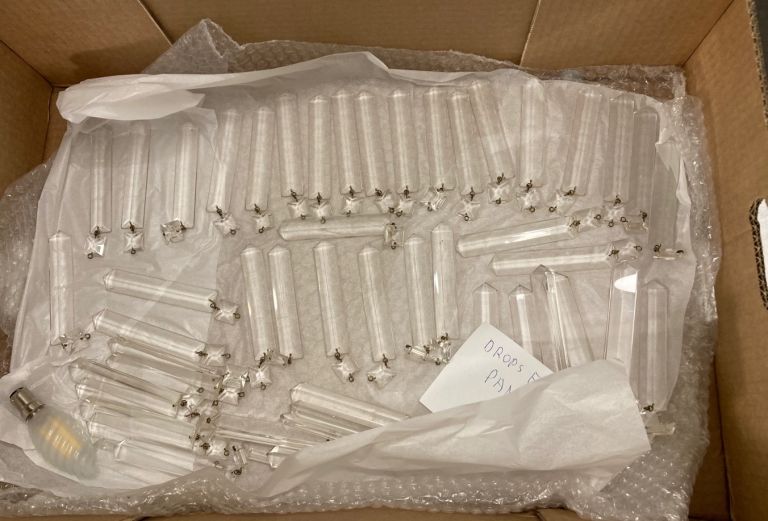
Collections care team volunteers, Emanuele Casafredda and Ava Salzer, detail the recent cleaning and conservation efforts in caring for our café chandelier.
Emanuele and Ava here again; Collections care volunteers! We are back with another blog to talk about more collections maintenance, cleaning, and conservation. In this case, we were asked to help with the large chandelier from the café that was undergoing some repairs! This beautiful 20th century, cut-glass crystal chandelier needed some specialist attention, so G&P Cohn were called for help. These antique chandelier experts came to disassemble the fixture and carefully pack all its parts for either removal to their facilities for work, or storage here at the Palace for conservation/cleaning. Although the major rewiring and some repair work would be completed off-site by the company, the cleaning and conservation of the many smaller crystals on the chandelier was left for us. The smaller crystals were packaged in layers for storage by crystal type, and location on the chandelier to allow for easy reassembly. These pieces were carefully packed in boxes using acid-free tissue and bubble wrap and were left in storage until it was time to get to cleaning and conservation!

Historically, chandeliers were an elaborate form of hanging candelabra – complete with oil wicks or wax candles! Chandeliers were extremely ornate and expensive so would only be found in religious or royal settings until the emergence of the merchant class. Crystal chandeliers were popularised initially in the 18th century as glassmakers honed their craft. Fixtures with hundreds of facetted and bevelled glass pieces were extremely sought after by those who could afford them. The extravagance of the lamps themselves was stylish, but it was the beauty of the incredible refraction of light achieved by the crystals that was most remarked. When gas lighting became common in the 19th century, chandelier design followed suit and branched fixtures with gas links were created that mimicked the shape of traditional chandeliers. Unsurprisingly, this same approach was taken with the emergence of electric light. Features like the candle cups and candle tubes in our Drawing Room chandelier recall these earlier designs and forms!
Our chandelier is designed with a basket shape and made with many different materials: a copper alloy core-body, over 200 cut-glass crystals with both prism and triangular shapes, and metal hooks and rings that link crystals together creating beautiful chains and pendants (they would also be perfect for wearing to a gala, don’t you think!?). It is a very bright chandelier, thanks to over 17 bulbs, and when it is switched on, a beautiful rainbow effect is projected from the inside of the structure onto the walls of the drawing room.

The cleaning and conservation process involved several steps. First, the crystals were carefully removed from their storage layer-by-layer so as not to mix up the order of assembly. All these pieces were then dry-cleaned using lint-free cloths, soft brushes and a lot of patience! A white goat hair brush was chosen specifically for dusting because this material does not create static electricity. This keeps the brush from attracting dust back to the object – other kinds of brush materials (like synthetic bristles) can create a static charge and collect particles! While this dry cleaning and dusting was completed, any more persistent staining or discolouration was identified for further cleaning with a non-ionic detergent on cotton swabs.
We use non-ionic detergents in conservation because they are gentle and non-reactive so they are less likely to cause any damage to museum objects. A cotton compress with detergent was applied to some stubborn paint stains to soak the debris that had adhered to the surface and could not be resolved with a simple swab. After soaking for a short while, these areas of paint were removed gently with a scalpel. Extreme care was taken not to scratch the crystals in this process! Nitrile gloves were also worn to protect against the transfer of fingerprints onto the crystals.
After each layer of crystals was cleaned, we carefully replaced them in their storage boxes using acid-free (archival grade) tissue paper, and bubble wrap to protect the fragile pieces. All these layers were cleaned over the course of several hours and put back to await the reassembly of the chandelier!
Come and visit us at the Palace and take a stroll through the drawing room cafe to see this magnificent light fixture – now reassembled and sparkling.
